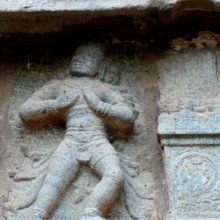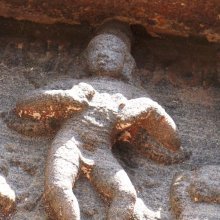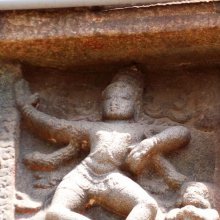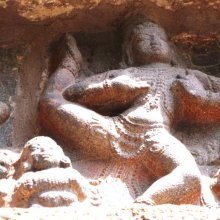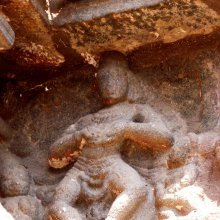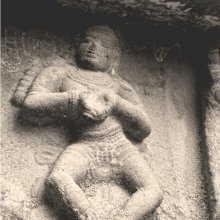Atikranta, Atikrāntā, Atikrānta, Atikramta: 16 definitions
Introduction:
Atikranta means something in Buddhism, Pali, Hinduism, Sanskrit, Jainism, Prakrit, Marathi. If you want to know the exact meaning, history, etymology or English translation of this term then check out the descriptions on this page. Add your comment or reference to a book if you want to contribute to this summary article.
Images (photo gallery)
In Hinduism
Natyashastra (theatrics and dramaturgy)
Source: Wisdom Library: Nāṭya-śāstra1a) Atikrānta (अतिक्रान्त).—One of the 108 karaṇas (minor dance movement) mentioned in the Nāṭyaśāstra chapter 4. The instructions for this atikrānta-karaṇa is as follows, “observing the Atikrānta Cārī, the two hands stretched forward in a manner befitting the dance.”.
A karaṇa represents a minor dance movements and combines sthāna (standing position), cārī (foot and leg movement) and nṛttahasta (hands in dancing position).
1b) Atikrānta (अतिक्रान्त) also refers to a one of the twenty maṇḍalas, according to the Nāṭyaśāstra chapter 12. The Atikrānta-maṇḍala is classified as a ākāśa, or “aerial”, of which there are ten in total. A maṇḍala is a combination of cārīs (“dance-steps”), which refers refers to the simultaneous movement of the feet (pāda), shanks (jaṅghā) and the hip (ūru). From these cārīs proceed dance as well as movements in general.
2) Atikrāntā (अतिक्रान्ता) refers to a one of the thirty-two cārīs, according to the Nāṭyaśāstra chapter 11. The Atikrāntā-cārī is classified as a ākāśikī, or “aerial”, of which there are sixteen in total. The term cārī refers to a “dance-step” and refers to the simultaneous movement of the feet (pāda), shanks (jaṅghā) and the hip (ūru). From these cārīs proceed dance as well as movements in general.
Source: archive.org: Natya Shastra1) Atikrāntā (अतिक्रान्ता).—A type of aerial (ākāśikī) dance-step (cārī);—Instructions: a Kuñcita foot thrown up, put forward and caused to fall on the ground.
2) Atikrāntā (अतिक्रान्ता).—A type of maṇḍala (series of cārīs) classified as aerial (ākāśa);—Instructions:
Source: Shodhganga: Elements of Art and Architecture in the Trtiyakhanda of the Visnudharmottarapurana (natya)1a) The right foot to be moved successively in the janitā-cārī and the śakaṭāsyā-cārī, in which the breast is udvāhita,
1b) The left foot in the alātā-cārī and the right foot in the pārśvakrāntā-cāri,
2) The left foot in the sūcī-cārī and the right foot in the apakrāntā-cārī,
3) The left foot successively in the sūcī-cārī and the bhramarī-cārī by turning the trika,
4) The right foot in the udvṛitta-cārī and the left foot in the alātā-cārī which should be changed (lit. divided) to the bhramarī-cārī,
5) The left foot in the alātā-cārī and the right foot in the daṇḍapāda-cārī.
Atikrānta (अतिक्रान्त) refers to one of the 108 kinds of Karaṇa (“coordination of precise movements of legs and hands”), according to the Viṣṇudharmottarapurāṇa, an ancient Sanskrit text which (being encyclopedic in nature) deals with a variety of cultural topics such as arts, architecture, music, grammar and astronomy.—According to the Viṣṇudharmottarapurāṇa, karaṇas are the coordination of precise movements of legs and hands performed in a particular posture. The Nāṭyaśāstra also gives its view point in the same spirit. In the Viṣṇudharmottarapurāṇa, one hundred and eight kinds of karaṇas are accepted, e.g., Atikrānta.

Natyashastra (नाट्यशास्त्र, nāṭyaśāstra) refers to both the ancient Indian tradition (shastra) of performing arts, (natya—theatrics, drama, dance, music), as well as the name of a Sanskrit work dealing with these subjects. It also teaches the rules for composing Dramatic plays (nataka), construction and performance of Theater, and Poetic works (kavya).
Shaivism (Shaiva philosophy)
Source: Shodhganga: Iconographical representations of ŚivaAtikrānta (अतिक्रान्त) or Atikrāntāgama refers to one of upāgamas (supplementary scriptures) of the Vimalāgama which is one of the twenty-eight Siddhāntāgama: a classification of the Śaiva division of Śaivāgamas. The Śaivāgamas represent the wisdom that has come down from lord Śiva, received by Pārvatī and accepted by Viṣṇu. The purpose of revealing upāgamas (e.g., Atikrānta Āgama) is to explain more elaborately than that of mūlāgamas (e.g., Vimala-āgama) and to include any new idea if not dealt in mūlāgamas.

Shaiva (शैव, śaiva) or Shaivism (śaivism) represents a tradition of Hinduism worshiping Shiva as the supreme being. Closely related to Shaktism, Shaiva literature includes a range of scriptures, including Tantras, while the root of this tradition may be traced back to the ancient Vedas.
In Buddhism
Mahayana (major branch of Buddhism)
Source: Wisdom Library: Maha Prajnaparamita SastraAtikrānta (अतिक्रान्त) refers to “that (body) which surpasses” (all the worlds), according to the 2nd century Mahāprajñāpāramitāśāstra chapter 1.—Accordingly: At the time of his birth, the Buddha came down to the earth, took seven steps and spoke some words, then was silent. Like all infants, he does not walk and does not talk; he suckles milk for three years; nurses feed him and he grows slowly. However the body of the Buddha is incalculable and surpasses all the worlds (sarvaloka-atikrānta). But he appears to beings as an ordinary man. [...]

Mahayana (महायान, mahāyāna) is a major branch of Buddhism focusing on the path of a Bodhisattva (spiritual aspirants/ enlightened beings). Extant literature is vast and primarely composed in the Sanskrit language. There are many sūtras of which some of the earliest are the various Prajñāpāramitā sūtras.
In Jainism
General definition (in Jainism)
Source: The University of Sydney: A study of the Twelve ReflectionsAtikrānta (अतिक्रान्त) refers to “having gone beyond” (virtuous meditation), according to the 11th century Jñānārṇava, a treatise on Jain Yoga in roughly 2200 Sanskrit verses composed by Śubhacandra.—Accordingly, “Then the wise [man] who has gone beyond virtuous meditation (atikrānta—atha dharmam atikrāntaḥ) and attained infinite purity commences to meditate on absolutely spotless pure [meditation]. He who is endowed with a robust physique etc., calm [and] whose behaviour is virtuous is also capable of meditating on pure meditation which is of four kinds of”.

Jainism is an Indian religion of Dharma whose doctrine revolves around harmlessness (ahimsa) towards every living being. The two major branches (Digambara and Svetambara) of Jainism stimulate self-control (or, shramana, ‘self-reliance’) and spiritual development through a path of peace for the soul to progess to the ultimate goal.
Languages of India and abroad
Marathi-English dictionary
Source: DDSA: The Molesworth Marathi and English Dictionaryatikrānta (अतिक्रांत).—p S Passed, traversed, crossed--space or time. 2 That has crossed or passed over. 3 Transgressed, exceeded, violated. Ex. of comp. ājñātikrānta &c. See under atikrama, and for krama substitute krānta.
Source: DDSA: The Aryabhusan school dictionary, Marathi-Englishatikrānta (अतिक्रांत).—p Passed, crossed, transgressed
Marathi is an Indo-European language having over 70 million native speakers people in (predominantly) Maharashtra India. Marathi, like many other Indo-Aryan languages, evolved from early forms of Prakrit, which itself is a subset of Sanskrit, one of the most ancient languages of the world.
Sanskrit dictionary
Source: DDSA: The practical Sanskrit-English dictionaryAtikrānta (अतिक्रान्त).—pp..
1) Exceeded, surpassed, go beyond &c.; सोतिक्रान्तः श्रवणविषयम् (sotikrāntaḥ śravaṇaviṣayam) Meghadūta 13; सुदूरमतिक्रान्तः (sudūramatikrāntaḥ) K.35 departed, gone; मनोरथ °दर्शना (manoratha °darśanā) Mālatīmādhava (Bombay) 1 beyond the reach even of desire; विचारातिक्रान्तः (vicārātikrāntaḥ) Mu.5.4 past the stage of thought; चक्षुर्विषयातिक्रान्तेषु पक्षिषु (cakṣurviṣayātikrānteṣu pakṣiṣu) H.1.
2) Past, gone by; °कुनृपति (kunṛpati) K.5, past, former; 169 Pañcatantra (Bombay) 1.333, Pañcatantra (Bombay) 2, Bhartṛhari 3.32; °पार्थिवगुणान् (pārthivaguṇān) Mu.1 former kings.
-tam A past thing, thing of the past, the past; °तं भगवति कथयति (taṃ bhagavati kathayati) M.5 your ladyship is speaking of the past; °ते धैर्यमवलम्ब्यताम् (te dhairyamavalambyatām) Uttararāmacarita 3; किं उपालम्भेन (kiṃ upālambhena) H.1; cf. 'let bygones be bygones' °योगिन् (yogin) a. with the moon in conjunction.
--- OR ---
Atikrāntā (अतिक्रान्ता).—Name of the sixth stage of the elephant's must; अतिक्रान्तावस्थो गजपतिरिदं स्थावरचरम्, जगत्सर्वं हन्तुं सम- भिलषति क्रोधकलुषः (atikrāntāvastho gajapatiridaṃ sthāvaracaram, jagatsarvaṃ hantuṃ sama- bhilaṣati krodhakaluṣaḥ) | Mātaṅga L.9.17.
Source: Cologne Digital Sanskrit Dictionaries: Edgerton Buddhist Hybrid Sanskrit DictionaryAtikrānta (अतिक्रान्त).—adj. (ppp.), surpassing, wonderful, (speci-fically of appearance) beautiful: atikrāntā (so mss., Senart abhi°) ca mānuṣāḥ Mahāvastu iii.96.19; 100.20; °ta-varṇa, of beautiful appearance, Lalitavistara 396.17; Mahāvastu iii.316.13; 317.11; also Mahāvastu ii.257.9; 258.7; iii.197.15; 302.10 (in these four Senart em. abhikrānta°). The equivalent Pali is regularly abhikkanta (-vaṇṇa), but atikkanta also occurs in the same sense (Critical Pali Dictionary s.v.). In [Buddhist Hybrid Sanskrit], in this sense, abhikrānta occurs, if at all, only in Lalitavistara 398.11 °ta varṇa, see abhi- krānta 2. Since t and bh are easily confused, it may be that graphic confusion is here concerned. On the other hand, atikrānta is erroneously read, e.g. in Divyāvadāna 462.13, for abhikrānta (1), which is correctly read in the same passage in Mūla-Sarvāstivāda-Vinaya i.70.3, and elsewhere in that text.
Source: Cologne Digital Sanskrit Dictionaries: Shabda-Sagara Sanskrit-English DictionaryAtikrānta (अतिक्रान्त).—mfn.
(-ntaḥ-ntā-ntaṃ) 1. Transgressed, exceeded, passed the proper bounds. 2. Excelled, surpassed. 3. Passed in time. 4. Attacked, assaulted. 5. Excessive, unlimited. 6. Prolix, diffuse. 7. Disregarded, disliked. E. ati, and krama to go, aff.
Source: Cologne Digital Sanskrit Dictionaries: Monier-Williams Sanskrit-English Dictionary1) Atikrānta (अतिक्रान्त):—[=ati-krānta] [from ati-kram] mfn. having passed or transgressed
2) [v.s. ...] exceeded, surpassed, overcome.
Source: Cologne Digital Sanskrit Dictionaries: Goldstücker Sanskrit-English DictionaryAtikrānta (अतिक्रान्त):—m. f. n.
(-ntaḥ-ntā-ntam) 1) Transgressed, exceeded, passed in time, excelled, surpassed, or
2) having transgressed, exceeded &c. See kram with ati. E. kram with ati, kṛt aff. kta.
Source: Cologne Digital Sanskrit Dictionaries: Yates Sanskrit-English DictionaryAtikrānta (अतिक्रान्त):—[ati-krānta] (ntaḥ-ntā-ntaṃ) a. Transgressed; excelled; attacked.
Source: DDSA: Paia-sadda-mahannavo; a comprehensive Prakrit Hindi dictionary (S)Atikrānta (अतिक्रान्त) in the Sanskrit language is related to the Prakrit words: Aikkaṃta, Aicchiya, Uvāiṇāviya.
Sanskrit, also spelled संस्कृतम् (saṃskṛtam), is an ancient language of India commonly seen as the grandmother of the Indo-European language family (even English!). Closely allied with Prakrit and Pali, Sanskrit is more exhaustive in both grammar and terms and has the most extensive collection of literature in the world, greatly surpassing its sister-languages Greek and Latin.
Kannada-English dictionary
Source: Alar: Kannada-English corpusAtikrāṃta (ಅತಿಕ್ರಾಂತ):—
1) [adjective] trespassed; overstepped.
2) [adjective] over; finished; died or extinct.
--- OR ---
Atikrāṃta (ಅತಿಕ್ರಾಂತ):—
1) [noun] one of the seven stages of an elephant in rut.
2) [noun] (dance) a posture in which hands are stretched forward.
3) [noun] (dance) an action including lifting, pushing forward and placing a foot on its side.
Kannada is a Dravidian language (as opposed to the Indo-European language family) mainly spoken in the southwestern region of India.
See also (Relevant definitions)
Starts with: Atikrantabhavaniya, Atikrantamanushyaka, Atikrantanishedha, Atikrantaprayashcitta, Atikrantashauca, Atikrantata, Atikrantatikranta, Atikrantavekshana, Atikrantayogin.
Ends with: Anatikranta, Apratikranta, Atikrantatikranta, Gananatikramta, Kriyapathamatikranta, Lokatikranta, Mahatikranta, Pancagatisamatikranta, Pratikranta, Samatikranta, Sarvalokatikranta, Varnavyatikranta, Vyatikranta.
Full-text (+30): Aicchiya, Atikrantanishedha, Atikaraka, Anatikranta, Aticchandas, Atikrantatikranta, Aticchanda, Vyatikranta, Atikrant, Atiguha, Atyupadha, Atipada, Aikkamta, Kriyapathamatikranta, Uvainaviya, Atyashti, Hariṇapluta, Atyukta, Atyuktha, Atijagati.
Relevant text
Search found 7 books and stories containing Atikranta, Atikrāntā, Atikrānta, Atikramta, Ati-kranta, Ati-krānta, Atikrāṃta; (plurals include: Atikrantas, Atikrāntās, Atikrāntas, Atikramtas, krantas, krāntas, Atikrāṃtas). You can also click to the full overview containing English textual excerpts. Below are direct links for the most relevant articles:
Natyashastra (English) (by Bharata-muni)
Cidgaganacandrika (study) (by S. Mahalakshmi)
Verse 165 [Khaṇḍacakra Vivarana Saṃhṛtikrama] < [Chapter 3 - Third Vimarśa]
Gati in Theory and Practice (by Dr. Sujatha Mohan)
Terukūttu < [Chapter 4 - Practice of Gati]
Performance of Cārī < [Chapter 2 - Concept and technique of Gati]
Performance of Gati through Maṇḍalas < [Chapter 2 - Concept and technique of Gati]
Vishnudharmottara Purana (Art and Architecture) (by Bhagyashree Sarma)
2.5. Karaṇa (movements of legs and hands) < [Chapter 3 - Drama and Dance]
Sushruta Samhita, Volume 6: Uttara-tantra (by Kaviraj Kunja Lal Bhishagratna)
Chapter LXV - The Technical terms used in the treatise < [Canto V - Tantra-bhusana-adhyaya (embellishing chapters)]
Dance Traditions of South India < [May-June 1935]
